Investing money is a critical step towards achieving financial independence and building wealth. With the right strategies, anyone can start investing, regardless of their financial background or experience level. The goal of this article is to provide you with actionable steps to begin investing effectively. Whether you're looking to save for retirement, build an emergency fund, or simply grow your wealth, understanding how to invest is essential.
The investment landscape has evolved significantly, making it more accessible than ever. New technologies and platforms allow individuals to invest with minimal amounts of money, while various investment vehicles cater to different risk appetites and financial goals. This guide will outline the fundamental steps to take when investing money, ensuring you make informed decisions that align with your financial objectives.
| Step | Description |
|---|---|
| 1 | Determine your investment goals. |
| 2 | Choose the right investment account. |
| 3 | Understand your investment options. |
| 4 | Develop an investment strategy. |
| 5 | Monitor and adjust your investments. |
Determine Your Investment Goals
Before you start investing, it is crucial to define your investment goals. These goals will guide your decisions and help you choose the right investments. Consider what you want to achieve with your investments:
- Are you saving for retirement?
- Do you want to buy a home?
- Are you looking to fund a child's education?
- Do you want to build wealth for future generations?
Setting clear and measurable goals will help you stay focused and motivated. Additionally, think about your time horizon—the length of time you expect to hold your investments before needing the funds. Short-term goals may require less risky investments, while long-term goals can afford more volatility.
Choose the Right Investment Account
Once you've established your investment goals, the next step is to choose the appropriate investment account. There are several types of accounts available:
- Brokerage Accounts: These accounts allow you to buy and sell various securities like stocks, bonds, and mutual funds without tax advantages.
- Retirement Accounts: Accounts like a 401(k) or IRA offer tax benefits for retirement savings but come with restrictions on withdrawals.
- Robo-Advisors: These automated platforms create and manage a diversified portfolio for you based on your risk tolerance and goals.
Selecting the right account depends on your financial situation and investment objectives. For example, if you're saving for retirement, consider opening a tax-advantaged retirement account.
Understand Your Investment Options
To make informed decisions, it's essential to understand the various investment options available:
- Stocks: Shares of ownership in a company that can provide high returns but come with higher risk.
- Bonds: Loans made to corporations or governments that typically offer lower returns but are generally considered safer than stocks.
- Mutual Funds: Pooled funds from multiple investors that are managed by professionals, offering diversification but often at a higher cost.
- Exchange-Traded Funds (ETFs): Similar to mutual funds but traded on stock exchanges like individual stocks; they often have lower fees.
Each option has its own risk-reward profile. It's important to assess how each aligns with your investment strategy and risk tolerance.
Develop an Investment Strategy
Creating an effective investment strategy is crucial for achieving your financial goals. Here are key components of a successful strategy:
- Asset Allocation: Decide how much of your portfolio will be allocated to different asset classes (stocks, bonds, etc.) based on your risk tolerance and time horizon.
- Diversification: Spread your investments across various sectors and asset classes to reduce risk.
- Investment Style: Choose between active investing (frequent buying/selling) or passive investing (buy-and-hold strategy). Passive investing often results in lower costs and less stress.
- Regular Contributions: Commit to regularly adding funds to your investments. This can be done through automatic transfers from your bank account.
A well-thought-out strategy will help you navigate market fluctuations and stay focused on long-term gains.
Monitor and Adjust Your Investments
Investing is not a "set it and forget it" endeavor. Regularly monitoring your investments is essential for ensuring they align with your goals. Here’s what you should do:
- Review performance periodically (e.g., quarterly or annually) to assess if you're on track.
- Rebalance your portfolio if necessary. If one asset class performs significantly better than others, it may skew your desired asset allocation.
- Stay informed about market trends and economic conditions that may impact your investments.
Adjusting based on performance and changing circumstances will help optimize returns while managing risks effectively.
FAQs About How To Invest Money Now
- What is the best way to start investing?
The best way is to set clear financial goals and choose an appropriate investment account. - How much money do I need to start investing?
You can start investing with as little as $5 thanks to many platforms offering fractional shares. - What types of investments should I consider?
Consider stocks, bonds, mutual funds, ETFs, or real estate based on your risk tolerance. - How often should I monitor my investments?
You should review them at least quarterly or whenever significant market changes occur. - Is it better to invest actively or passively?
This depends on your preferences; passive investing typically incurs lower fees and requires less time.
Investing money now can be a rewarding journey if approached thoughtfully. By determining clear goals, choosing the right accounts, understanding options, developing a solid strategy, and regularly monitoring progress, you can build a robust investment portfolio that aligns with your financial aspirations. Remember that patience and consistency are key components of successful investing—start today!

